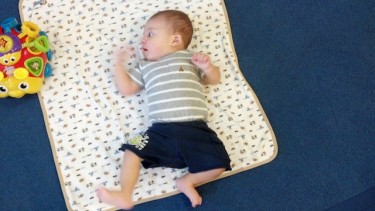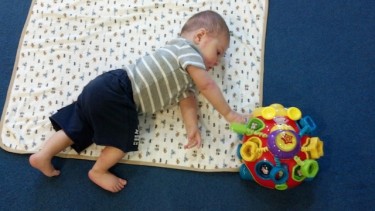Lately, as a physical therapist, I have had many referrals to treat a condition known as Torticollis or “wryneck.” This is a condition where your baby has a twist in his neck. His head is tipped down to one side, with his face turned to the other side. Your baby will have difficulty moving his head from side to side and will also have difficulty keeping his eyes looking toward the front of his body. A big muscle in your baby’s neck is tight, inhibiting your baby from having full range of motion. This can also cause a flattening of his skull called plagiocephaly and if full motion is not achieved your baby’s head may continue to have this flat spot.
 If you suspect that your baby has Torticollis, please make an appointment with your pediatrician immediately. If your baby was diagnosed with Torticollis, a physical therapist can help teach specific stretching techniques. Whether or not your baby has Torticollis, it is always important to be cognizant of positioning your baby so he does not prefer turning to one cheek.
If you suspect that your baby has Torticollis, please make an appointment with your pediatrician immediately. If your baby was diagnosed with Torticollis, a physical therapist can help teach specific stretching techniques. Whether or not your baby has Torticollis, it is always important to be cognizant of positioning your baby so he does not prefer turning to one cheek.
If you bottle feed, make sure to change holding arms, allowing for your baby to feed from the bottle with his head turned towards you. If you continually bottle feed your baby in only one arm, you are not allowing for his head to rotate in the opposite direction.
When you are holding your baby, with his cheek on your shoulder, make sure to facilitate his resting comfortably on each cheek for a few minutes at a time instead of allowing him to keep his preferred position. Or switch holding arms if he likes to turn away.
Supervised tummy time is another great opportunity to allow for your baby’s head to not rest on the floor or crib. This position will allow for the back of his head to not be compressed. In tummy time, encourage him to clear his face and rotate his head resting on each check. Pushing up on his forearms increases neck and back strength and helps keep his head straight in the middle.
 Another great position is side-lie. Do not let him favor one side over the other. This position will help his face rotate towards center.
Another great position is side-lie. Do not let him favor one side over the other. This position will help his face rotate towards center.
When placing your baby on the play mat on his back, change your position on the side of his body to encourage him to rotate his head to look at you. Encourage this activity with rattles, songs, toys, facial expressions -pretty much anything to get him to turn his head and look at you. Also while he is on his back dangle objects straight above his body and encourage him to look straight at you. This will also promote perception, and reaching and grasping skills.
Once again, if your baby was diagnosed with Torticollis then all of these tips, with the help of your pediatrician and possibly a physical therapist, will help improve your baby’s head/neck movement to facilitate typical development.
Amanda Math MPT, is the principal Physical Therapist at Jumping Jax. She has extensive experience working with children of all ages. Amanda has been evaluating and treating infants, toddlers and children with a wide variety of developmental, neurological, musculoskeletal, and congenital impairments. She incorporates her passion for physical therapy with her love of athletics and has completed extensive course work. Amanda has presented multiple workshops for Special Education Preschools and Elementary Schools throughout her career on a variety of developmental, neurological and musculoskeletal topics.




Comments are closed.